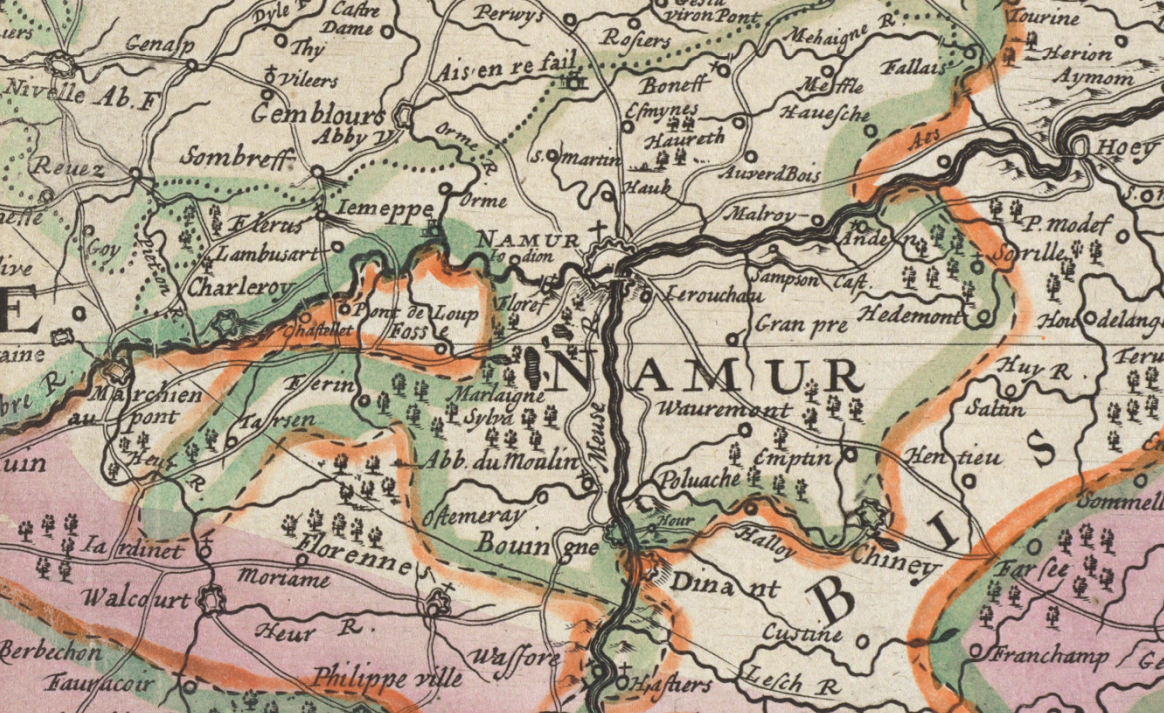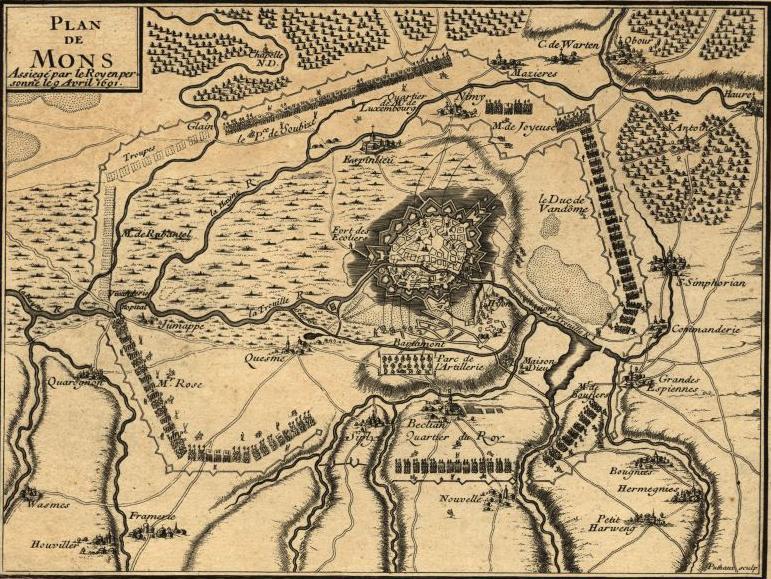|
Siege Of Namur (1692)
The siege of Namur, 25 May–30 June 1692, was a major engagement of the Nine Years' War, and was part of the French grand plan (devised over the winter of 1691–92) to defeat the forces of the Grand Alliance and bring a swift conclusion to the war. Namur, sitting on the confluence of the Meuse and Sambre rivers, was a considerable fortress, and was a significant political and military asset. French forces, guided by Vauban, forced the town's surrender on 5 June, but the citadel, staunchly defended by Menno van Coehoorn, managed to hold on until 30 June before capitulating, bringing an end to the 36-day siege. Concerned that King William III planned to recapture the stronghold, King Louis XIV subsequently ordered his commander-in-chief, the duc de Luxembourg, to join battle with the Allies in the field, resulting in the bloody Battle of Steenkerque on 3 August. Background As in 1691, five large armies were created for the five major fronts of the war: Flanders, the Moselle, t ... [...More Info...] [...Related Items...] OR: [Wikipedia] [Google] [Baidu] |
Nine Years' War
The Nine Years' War (1688–1697), often called the War of the Grand Alliance or the War of the League of Augsburg, was a conflict between Kingdom of France, France and a European coalition which mainly included the Holy Roman Empire (led by the Habsburg monarchy), the Dutch Republic, Kingdom of England, England, Spanish Empire, Spain, Duchy of Savoy, Savoy, Swedish Empire, Sweden and Portuguese Empire, Portugal. Although not the first European war to spill over to Europe's overseas colonies, the events of the war spread to such far away places as the Americas, India, and West Africa. It is for this reason that it is sometimes considered the first world war. The conflict encompassed the Glorious Revolution in England, where William III of England, William of Orange deposed the unpopular James II of England, James VII and II and subsequently struggled against him for control Jacobite rising of 1689, of Scotland Williamite war in Ireland, and Ireland, and King William's War, a cam ... [...More Info...] [...Related Items...] OR: [Wikipedia] [Google] [Baidu] |
Moselle River
The Moselle ( , ; german: Mosel ; lb, Musel ) is a river that rises in the Vosges mountains and flows through north-eastern France and Luxembourg to western Germany. It is a left bank tributary of the Rhine, which it joins at Koblenz. A small part of Belgium is in its basin as it includes the Sauer and the Our. Its lower course "twists and turns its way between Trier and Koblenz along one of Germany's most beautiful river valleys."''Moselle: Holidays in one of Germany's most beautiful river valleys'' at www.romantic-germany.info. Retrieved 23 Jan 2016. In this section the land to the north is the Eifel which stretches into [...More Info...] [...Related Items...] OR: [Wikipedia] [Google] [Baidu] |
Mehaigne
The Mehaigne () is a river in Belgium. It is a left tributary to the Meuse. Its source is at Saint-Denis ( La Bruyère), in the province of Namur, at an elevation of . The Mehaigne flows in a roughly eastern direction through a region called Hesbaye The Hesbaye ( French, ), or Haspengouw ( Dutch and Limburgish, ) is a traditional cultural and geophysical region in eastern Belgium. It is a loamy plateau region which forms a watershed between the Meuse and Scheldt drainage basins. It ha .... It flows into the river Meuse in the municipality of Wanze at an elevation of . Rivers of Belgium Rivers of Namur (province) Rivers of Limburg (Belgium) Rivers of Liège Province {{Belgium-river-stub ... [...More Info...] [...Related Items...] OR: [Wikipedia] [Google] [Baidu] |
Gembloux
Gembloux (; wa, Djiblou; nl, Gembloers, ) is a city and municipality of Wallonia located in the province of Namur, Belgium. On 1 January 2006 the municipality had 21,964 inhabitants. The total area is 95.86 km², yielding a population density of 229 inhabitants per km². The mayor, who was elected on 8 October 2006, is Benoît Dispa. The municipality consists of the following districts: Beuzet, Bossière, Bothey, Corroy-le-Château, Ernage, Gembloux, Grand-Leez, Grand-Manil, Isnes, Lonzée, Mazy, and Sauvenière. This city is well known for its Agricultural University and for its cutlery. The university is housed in the historical Abbey of Gembloux, which dates from the tenth century. Gembloux's belfry is a UNESCO World Heritage Site, as part of the Belfries of Belgium and France site, in recognition of its architecture and testimony to the rise in municipal power in the area. History The central city grew around the Gembloux Abbey, founded in the tenth centur ... [...More Info...] [...Related Items...] OR: [Wikipedia] [Google] [Baidu] |
Artillery Battery
In military organizations, an artillery battery is a unit or multiple systems of artillery, mortar systems, rocket artillery, multiple rocket launchers, surface-to-surface missiles, ballistic missiles, cruise missiles, etc., so grouped to facilitate better battlefield communication and command and control, as well as to provide dispersion for its constituent gunnery crews and their systems. The term is also used in a naval context to describe groups of guns on warships. Land usage Historically the term "battery" referred to a cluster of cannon in action as a group, either in a temporary field position during a battle or at the siege of a fortress or a city. Such batteries could be a mixture of cannon, howitzer, or mortar types. A siege could involve many batteries at different sites around the besieged place. The term also came to be used for a group of cannon in a fixed fortification, for coastal or frontier defence. During the 18th century "battery" began to be used a ... [...More Info...] [...Related Items...] OR: [Wikipedia] [Google] [Baidu] |
Investment (military)
Investment is the military process of surrounding an enemy fort (or town) with armed forces to prevent entry or escape. It serves both to cut communications with the outside world and to prevent supplies and reinforcements from being introduced. A contravallation is a line of fortifications, built by the attackers around the besieged fortification facing towards an enemy fort to protect the besiegers from sorties by its defenders and to enhance the blockade. The contravallation can be used as a base to launch assaults against the besieged city or to construct further earthworks nearer to the city. A circumvallation may be constructed if the besieging army is threatened by a field army allied to an enemy fort. It is a second line of fortifications outside the contravallation that faces away from an enemy fort. The circumvallation protects the besiegers from attacks by allies of the city's defenders and enhances the blockade of an enemy fort by making it more difficult to smuggle ... [...More Info...] [...Related Items...] OR: [Wikipedia] [Google] [Baidu] |
Siege Of Mons (1691)
The siege of Mons, 15 March–10 April 1691, was a major operation fought during the Nine Years' War, and was the main French objective for the 1691 campaign in the Spanish Netherlands. The city was besieged and captured before the normal commencement of the campaigning season with minimal losses. The outcome was not in doubt, but in a conflict dominated by siege warfare, neither the French army of King Louis XIV, nor the forces of the Grand Alliance under King William III, could bring about a decisive battle. After the siege the duc de Boufflers bombarded the neutral city of Liège, whilst the duc de Luxembourg captured Halle, and scored a minor victory against the Prince of Waldeck at the Battle of Leuze in September. Strategically, however, little had changed in the war, and both combatants returned to winter quarters at the end of the campaigning season. Background French forces had secured considerable success in 1690. In July Luxembourg fought and won his tactical maste ... [...More Info...] [...Related Items...] OR: [Wikipedia] [Google] [Baidu] |
Jean Racine
Jean-Baptiste Racine ( , ) (; 22 December 163921 April 1699) was a French dramatist, one of the three great playwrights of 17th-century France, along with Molière and Corneille as well as an important literary figure in the Western tradition and world literature. Racine was primarily a tragedian, producing such "examples of neoclassical perfection" as ''Phèdre'', ''Andromaque'', and '' Athalie''. He did write one comedy, '' Les Plaideurs'', and a muted tragedy, ''Esther'' for the young. Racine's plays displayed his mastery of the dodecasyllabic (12 syllable) French alexandrine. His writing is renowned for its elegance, purity, speed, and fury, and for what American poet Robert Lowell described as a "diamond-edge", and the "glory of its hard, electric rage". Racine's dramaturgy is marked by his psychological insight, the prevailing passion of his characters, and the nakedness of both plot and stage. Biography Racine was born on 21 December 1639 in La Ferté-Milon ( Ai ... [...More Info...] [...Related Items...] OR: [Wikipedia] [Google] [Baidu] |
Treaty Of Limerick
}), signed on 3 October 1691, ended the 1689 to 1691 Williamite War in Ireland, a conflict related to the 1688 to 1697 Nine Years' War. It consisted of two separate agreements, one with military terms of surrender, signed by commanders of a French expeditionary force and Irish Jacobites loyal to the exiled James II. Baron de Ginkell, leader of government forces in Ireland, signed on behalf of William III and his wife Mary II. It allowed Jacobite units to be transported to France, the diaspora known as the Flight of the Wild Geese. The other set out conditions for those who remained, including guarantees of religious freedom for Catholics, and retention of property for those who remained in Ireland. Many were subsequently altered or ignored, establishing the Protestant Ascendancy that dominated Ireland until the Catholic emancipation in the first half of the 19th century. Background William's victory at the Battle of Boyne in July 1690 was less decisive than appeared at the ti ... [...More Info...] [...Related Items...] OR: [Wikipedia] [Google] [Baidu] |
Williamite War In Ireland
The Williamite War in Ireland (1688–1691; ga, Cogadh an Dá Rí, "war of the two kings"), was a conflict between Jacobite supporters of deposed monarch James II and Williamite supporters of his successor, William III. It is also called the Jacobite War in Ireland, Williamite Conquest of Ireland, or the Williamite–Jacobite War in Ireland. The proximate cause of the war was the Glorious Revolution of 1688, in which James, a Catholic, was overthrown as king of England, Ireland and Scotland and replaced by his Protestant daughter Mary and nephew and son-in-law William, ruling as joint monarchs. James's supporters initially retained control of Ireland, which he hoped to use as a base for a campaign to reclaim all three kingdoms. The conflict in Ireland also involved long-standing domestic issues of land ownership, religion and civic rights; most Irish Catholics supported James in the hope he would address their grievances. A small number of English and Scottish Catholics, a ... [...More Info...] [...Related Items...] OR: [Wikipedia] [Google] [Baidu] |
James II Of England
James VII and II (14 October 1633 16 September 1701) was King of England and King of Ireland as James II, and King of Scotland as James VII from the death of his elder brother, Charles II, on 6 February 1685. He was deposed in the Glorious Revolution of 1688. He was the last Catholic monarch of England, Scotland, and Ireland. His reign is now remembered primarily for conflicts over religious tolerance, but it also involved struggles over the principles of absolutism and the divine right of kings. His deposition ended a century of political and civil strife in England by confirming the primacy of the English Parliament over the Crown. James succeeded to the thrones of England, Ireland, and Scotland following the death of his brother with widespread support in all three countries, largely because the principles of eligibility based on divine right and birth were widely accepted. Tolerance of his personal Catholicism did not extend to tolerance of Catholicism in general, and the ... [...More Info...] [...Related Items...] OR: [Wikipedia] [Google] [Baidu] |





